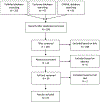Physical Activity, Injurious Falls, and Physical Function in Aging: An Umbrella Review
- PMID: 31095087
- PMCID: PMC6527126
- DOI: 10.1249/MSS.0000000000001942
Physical Activity, Injurious Falls, and Physical Function in Aging: An Umbrella Review
Abstract
Purpose: To review and update the evidence of the relationship between physical activity, risk of fall-related injury, and physical function in community-dwelling older people that was presented in the 2018 Physical Activity Guidelines Advisory Committee Scientific Report (PAGAC Report).
Methods: Duplicate independent screenings of 1415 systematic reviews and meta-analyses published between 2006 and 2016 identified from PubMed®, Cochrane Library, and CINAHL databases yielded 111 articles used for the PAGAC Report. The PAGAC Aging Subcommittee members graded scientific evidence strength based upon a five-criteria rubric and assigned one of four grades: strong, moderate, limited, or not assignable. An updated search of 368 articles published between January 2017 and March 2018 yielded 35 additional pertinent articles.
Results: Strong evidence demonstrated that physical activity reduced the risk of fall-related injuries by 32% to 40%, including severe falls requiring medical care or hospitalization. Strong evidence also supported that physical activity improved physical function and reduced the risk of age-related loss of physical function in an inverse graded manner among the general aging population, and improved physical function in older people with frailty and with Parkinson's disease. Aerobic, muscle-strengthening, and/or multicomponent physical activity programs elicited the largest improvements in physical function in these same populations. Moderate evidence indicated that for older adults who sustained a hip fracture or stroke, extended exercise programs and mobility-oriented physical activity improved physical function.
Conclusions: Regular physical activity effectively helps older adults improve or delay the loss of physical function and mobility while reducing the risk of fall-related injuries. These important public health benefits underscore the importance of physical activity among older adults, especially those living with declining physical function and chronic health conditions.
Conflict of interest statement
Conflicts of Interest and Source of Funding
The results of this study are presented clearly, honestly, and without fabrication, falsification, or inappropriate manipulation. The Committee’s work was supported by the U.S. Department of Health and Human Services (HHS). Committee members were reimbursed for travel and per diem expenses for the five public meetings; Committee members volunteered their time. The authors report no other potential conflicts of interest.
Figures



References
-
- Administration on Aging, US Department of Health and Human Services. A profile of older Americans: 2016. Washington, DC: US Department of Health and Human Services; 2016.
-
- Physical Activity Guidelines Advisory Committee. Physical Activity Guidelines Advisory Committee Report, 2008. Washington, DC: US Department of Health and Human Services; 2008. https://health.gov/paguidelines/guidelines/report.aspx. Published 2008. Accessed January 4, 2018.
-
- US Department of Health and Human Services. Physical activity guidelines for Americans. 2nd Edition Washington, DC: US DHHS, 2018.

